#duke of valencia
Explore tagged Tumblr posts
Photo

Ramón María Narváez, 1st Duke of Valencia. By Vicente López Portaña.
#vicente lópez portaña#monarquia española#ducado de valencia#full length portrait#spanish aristocracy#duke of valencia
3 notes
·
View notes
Text

Ferdinand of Aragon, Duke of Calabria and Viceroy of Valencia (1488-1550). Unknown artist.
#monarquía española#casa de trastámara#regno di napoli#italian aristocracy#duke of calabria#ducato di calabria#valencia#viceroy of valencia#full length portrait#beaded men
2 notes
·
View notes
Text
character tags pt 1.
#¸·¯ ✩ (ch: lachlan barrera-brewer)#¸·¯ ✩ (ch: rio valencia)#¸·¯ ✩ (ch: sydney velazquez)#¸·¯ ✩ (ch: phoenix delacruz)#¸·¯ ✩ (ch: teddy chambers)#¸·¯ ✩ (ch: tommy duke)#¸·¯ ✩ (ch: alexandre rivera)#¸·¯ ✩ (ch: kyan glover)#¸·¯ ✩ (ch: quinn talbot)#¸·¯ ✩ (body: lachlan)#¸·¯ ✩ (body: rio)#¸·¯ ✩ (body: sydney)#¸·¯ ✩ (body: phoenix)#¸·¯ ✩ (body: teddy)#¸·¯ ✩ (body: tommy)#¸·¯ ✩ (body: alexandre)#¸·¯ ✩ (body: kyan)#¸·¯ ✩ (body: quinn)#¸·¯ ✩ (musings: lachlan)#¸·¯ ✩ (musings: rio)#¸·¯ ✩ (musings: sydney)#¸·¯ ✩ (musings: phoenix)#¸·¯ ✩ (musings: teddy)#¸·¯ ✩ (musings: tommy)#¸·¯ ✩ (musings: alexandre)#¸·¯ ✩ (musings: kyan)#¸·¯ ✩ (musings: quinn)
0 notes
Text
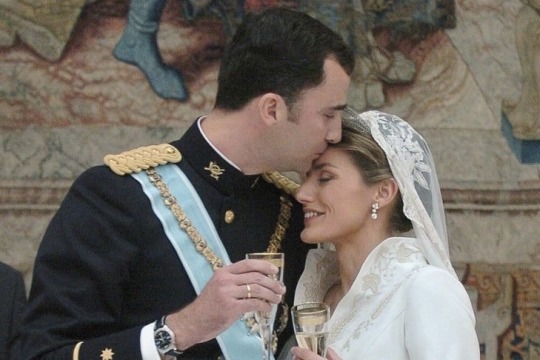

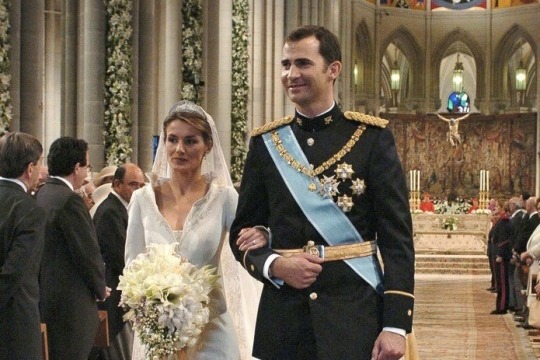
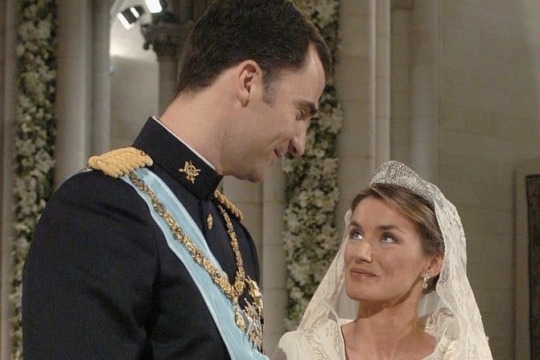
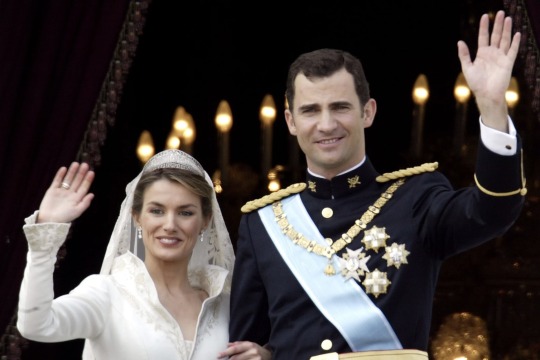
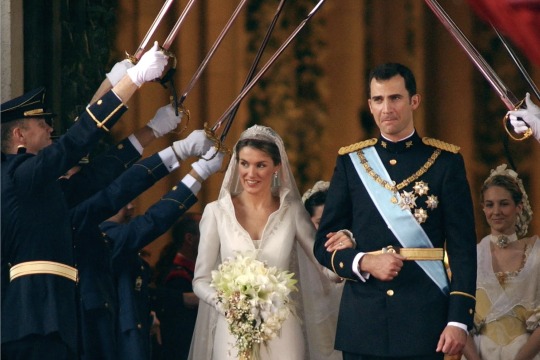
The royal wedding of Felipe, the Prince of Asturias and Letizia Ortiz ♡
The wedding of Prince Felipe and Letizia Ortiz was held on May 22nd 2004, in the Santa María la Real de La Almudena Cathedral at the Royal Palace of Madrid, Spain. The couple’s engagement was announced on November 1st, 2003.
The wedding was the first state wedding in Spain for more than 50 years, and the first royal wedding in almost a century to be held in the Spanish capital. More than 1200 guests attended the wedding, including from 36 royal houses and almost every head of state from Latin America.
Letizia wore the Prussian Tiara, also worn by Queen Sofia at her wedding. The wedding dress, designed by Manuel Pertegaz, was white, tight around the waist, with long sleeves, a neckline in the shape of a corolla, a wide skirt and a 4.5-meter long train embroidered with heraldic motifs. The bride's gown was woven with Valencia silk and embroidered with silver and gold threads. The nuptial veil was a gift from the Prince to Letizia; with a triangular shape, three meters long by two wide, of natural silk tulle in ivory white with scrolls and hand-embroidered wreaths, which mixed the fleur-de-lis and the spike. The shoes were made by the illicitana designer Pura López. Felipe wore the Great Tag suit of the Army.
Upon the wedding, Letizia received all constitutional titles recognized to the Prince as heir to the Spanish throne, such as: The Prince and Princess of Asturias, the title of the heir of the Crown of Castile; The Prince and Princess of Gerona, the title of the heir of the Crown of Aragón; The Prince and Princess of Viana, the title of the heir of the Kingdom of Navarre; The Duke and Duchess of Montblanch; The Count and Countess of Cervera; The Lord and Lady of Balaguer.
The royal wedding was broadcast by Spanish public television, reaching a national record as the most-watched television program ever with 25.1 million viewers in Spain alone. Approximately 5,600 media outlets from around the world covered the wedding with a potential audience of between 1.2 and 2 billion.
68 notes
·
View notes
Note
Okay I can see various fire emblem lords being big horseback riders and skilled in equestrian riding.
The jugral lords being into dressage, the hoshido nobles being into horse racing, I can see the tellius lords being into cross country, and show jumping being popular in Valencia.
Thoughts on horseback riding and fire emblem lords?
Oh!
It depends for the Jugdral Lords, if you mean Siggy, Eldie and Quan then yeah, maybe dressage was prevalent in their places, maybe just to show their mastery over their horses.
However, Seliph and Leif weren't raised in the same "environment", with Seliph wanting to emulate Shanan rather than his dad through Oifey lol
As for Leif, being on the run since age 4 sure didn't help him take riding lessons, even if I'm pretty sure Finn wanted to have that covered!
TFW both Hoshido and Nohr enjoy horse racing (tenma racing for Hoshido, they don't have pony classes, so most likely no pony in Hoshido?).
Imagine Elibe : Lycian Lords love cross-country and love participating in contests... but then Lyn's grandpa has the idea to bring a Sacaen golden horse to the contest, and it's a drama : Sacaen Golden Horse can cross rivers and forests with ease, it can jump to 10 meters with his rider.
Lord Caelin is thus banned from ever entering a cross country contest with his "foreign" horses - which raises a shitstorm because it's not cheating, and maybe the Lycian horses should be trained just like their Sacaen cousins as well - have you seen Lord Eliwood's horse?
Lord Caelin being overjoyed when his great-granddaughter Sue asked him to name her first horse and writing him letters about how his horse loves the Caelin carrots
Tellius nobles don't usually ride horses for war, but more as an demonstration of etiquette and for leisure.
However, duke Persis, cannot ride horses for shit - even if he lost his powers, his laguz instincts are still there to make him fall from any horse, but hopefully, Begnion Senators aren't expected to ride horses unless necessary (which might or not be the reason why he lent warp powder to Lekain and oversaw the development of warp staves).
Alm'n'Celica?
Rode the hell out of Grandpapa's Mycen horse when their were kids, hell, Mycen taught every kid in Ram Village how to ride a horse - not necessarily how to fight on horseback, but just, you know, how to "not fall" when sitting on a moving horse.
Zofian Nobles enjoy horse racing for the "noblest/purest" ones, the others help in the fields, but in Rigel they're more valued so put under less stress - and when their time come, they're also used for their meat.
Fodlan wise?
Adrestia being in dressage too - which utterly puzzles Faerghans who use their horses for war or to plow the fields that can be worked even in winter (aka not galatea lol) - and while Leicester also had a history with horse racing, its nobles, who want to emulate Adrestia, thinks it's vulgar and want to start the trend of dressage too.
Too bad for them, horse racing has such a massive following and is actually a not that ridiculous part of Leicester's economy in Gloucester's own territory that horses are still, mostly, used for racing.
For their part, full-blooded Nabateans, much like Lehran, cannot ride horses for shit. Let it be Seteth or Rhea, whenever they "sit" on a horse, they fall within seconds. Flayn hopefully can ride better than the rest of her fam, and back in the days, Saint Indech was a beast at Chariot Racing in the newly founded Adrestia : but given how Chariot Racing became highly political in Enbarr, Empress Fredegund III banned it in 354.
#nova-izumo#replies#FE series#FE nonsense#idk if i replied to your ask lol#but it was fun to think about
8 notes
·
View notes
Text

Columbano Bordalo Pinheiro (1857-1929) "Tragedy of Inês de Castro" (1901-1904) Realism Located in the Museu Militar de Lisboa, Lisbon, Portugal Inês de Castro (1325-1355) was a Galician noblewoman and courtier, best known as lover and posthumously-recognized wife of King Peter I of Portugal. The dramatic circumstances of her relationship with Peter (at the time Prince of Portugal), which was forbidden by his father King Afonso IV, her murder on the orders of Afonso--she was decapitated in front of one of her young children—Peter's bloody revenge on her killers—he captured two of them and publicly executed them by ripping their hearts out, claiming they didn't have one after pulverizing his own heart—and the legend of the coronation of her exhumed corpse by Peter, have made Inês de Castro a frequent subject of art, music, and drama through the ages.
Inês and Peter also had several children, whom he would legitimize after her death. Afonso, died shortly after birth. John, Duke of Valencia de Campos, claimant to the throne during the 1383–85 Crisis. Denis, Lord of Cifuentes, claimant to the throne during the 1383–1385 Crisis. And Beatrice, who married Sancho Alfonso, 1st Count of Alburquerque, the great-grandmother of Ferdinand II of Aragon and thereby an ancestor of all Spanish monarchs.
#paintings#art#artwork#history painting#tragic love#columbano bordalo pinheiro#fine art#realism movement#lisbon military museum#museum#art gallery#portuguese artist#history#tragedy#doomed love#forbidden love#portugal#monarchy#early 1900s#early 20th century
109 notes
·
View notes
Text
Suchet and Soult, 1813
That Napoleon’s marshals in Spain most of the time were busy being at odds with each other is well-known. Marshals Soult and Suchet were no exception. Suchet in particular seems to have rather disliked Soult, if it is true that as early as 1805 he specifically wanted to leave Soult’s army corps and had himself be transferred to Lannes’ instead. Their relations probably did not get much better in Spain, considering the animosity between Joseph and Soult, and Suchet’s close family relations with Joseph.
Suchet seems to have had a bit of a reputation for being the jealous kind. In any case, if this scene from 1813 is to be believed, he was not ready to be under the command of Soult under any circumstances, not even for the sake of France. It’s from the "Mémoires anecdotiques" by general Armand Alexandre Hippolyte Marquis de Bonneval, whose author had become Soult’s aide de camp quite against his will, but apparently, by the time they reached Spain, despite himself was already fully included in his military family.
Context: After an insuccessful attempt to save Pamplona, Soult, rather belatedly charged by Napoleon to take full command in Spain in summer 1813, when Joseph had lost the battle of Vitoria, wanted to unite what was left of Joseph’s forces with those still under the command of Marshal Suchet, in order to defend France’s borders from Wellington’s approaching army. He thus needed to contact Suchet in Catalonia. Bonneval writes:
I was entrusted with this mission and went via Perpignan to Barcelona, where Marshall Suchet was. He listened to me with complacency; then, after having discussed at length the arrangements to be made to effect this junction, he declared it necessary to make a movement in the direction of Valencia to sweep away the Spanish armies and thus ensure the safety of the portion of his army he would leave in Catalonia. So we set off, and having achieved the goal Marshal Suchet had in mind, we returned to Barcelona.
And it was on the journey back that Soult’s idea was discussed once more.
While riding side by side with me, Marshal Suchet asked me: "What will my position be with regard to Marshal Soult, Monsieur de Bonneval?" - "But," I replied, "Monsieur le maréchal, it can only be, in any case, that of a marshal of the Empire; however, if Your Excellency asks me if Marshal Soult will be willing to give up his position of seniority and lieutenant of the Emperor, my mission does not go as far as that." The marshal turned very cold and stopped talking to me.
As a matter of fact, according to Bonneval, Suchet at this point had decided that Soult’s plan was "untimely and inconvenient". Bonneval tried to talk him out of that, but in vain.
He persisted; and I saw that there was nothing to do but to take leave of him and return to Marshal Soult. On arriving at Saint-Jean de Luz, at about 2 o'clock in the morning, I found my comrades at table over champagne and oysters. They all stood up and invited me to join in the feast.
Because apparently, even without the original line-up of Saint-Chamans, Lameth, Soult’s brother Pierre etc., the tradition of all-night parties was still kept alive.
"I shall return to you shortly," I told them, "but first I must go and make the Marshal swallow the biggest of all oysters." When I arrived at his place, Marshal Soult was awake; in fact, he never slept with more than one eye closed. "Ah! it's you, my dear Bonneval," he said to me. "Is Marshal Suchet on his way?"- "He is still in Barcelona, Monsieur le Maréchal, certainly sleeping better than you." And I gave him all the details of my failure. He then burst into a holy rage against the foolish pride and ineptitude of the Duke of Albufera, throwing his cap at the ceiling and hurling the foulest words in his vocabulary. Then, calmer again: "Go and rest, my dear friend," he said. I went straight to the oysters and champagne.
That last sentence is just 😂. Obviously, everybody had their priorities straight.
Interestingly enough, Bonneval later, like Saint-Chamans, would become a staunch royalist and have a fall-out with Soult for political reasons. Yet he apparently always held Soult in high esteem personally, and claims to always have hoped Soult would "see reason" and "return to the path of honour", i.e., to the cause of the older branch of Bourbons.
22 notes
·
View notes
Note
Have you ever done a Wyll run in which you kill Karlach? Really curious what changes, how his romance is adjusted, etc. I know some little things (the robot at the gate bridge in act 3 recognises him as the Dukes son and actually lets you pass) but I’m really curious how his development and romance plays out, when one of the heavy beats early on during a regular run is his shame at his new devilish features.
Valencia had Karlach killed, but then also sided with Minthara at the grove so Wyll left of course, meaning I never got to see him past act 1. Then I couldn't load her save after the most recent patch so I need to start over with her sometime.
9 notes
·
View notes
Text
SAINT OF THE DAY (October 10)

Francis Borgia was born on 28 October 1510 in Gandia, Valencia, Spain.
The great-grandson of both Pope Alexander VI and King Ferdinand II of Aragon, he was Duke of Gandía and a grandee of Spain.
Francis’ grandmother joined her daughther in a convent of Poor Clares after the death of her husband and held a pious influence in the court of the Borgia, to which Francis is indebted.
It was with these two women that holiness penetrated into the scandalous lineage of the Borgia family.
Francis grew to be a pious young man, posessed of many natural gifts and a favorite at the court of Charles V.
It is recounted that one day, Francis passed through Alcalá, followed by his escort, and exchanged an emotional glance with a poor man being escorted to prison by the Inquisition. This man was Ignatius of Loyola.
At that moment, Francis could not have had any idea what an important role this man would play in his destiny.
In 1539, Francis was appointed Viceroy of Catalonia.
He built a university there, received the degree of Doctor in Theology, and invited the Jesuits to his duchy.
His wife died in 1546, and Francis entered the Society of Jesus in 1548.
However, he was ordered by the Pope to remain in the world until he had fulfilled his obligations to his ten children and his duchy.
Two years later, he left Gandia, never to return, and joined the Jesuits in Rome.
He immediately set about initiating grand projects. He convinced Ignatius to found the Roman College.
One year later, he left for Spain, where his preaching and example sparked a renewal of religious fervour in the country, drawing pilgrims from far and wide to hear him preach.
In 1556, he was placed in charge of all the missions of the Society, and his energetic work transformed them. He also initiated the missions to Peru, New Spain, and Brazil.
He was elected as general on 2 July 1565, and although in poor health for his last years, he executed the governance and initiated projects of the Society with great energy.
He introduced so many reforms to the society of Jesus that he was considered in some ways to be its second founder.
Francis was a man of contemplation and action in the fullest sense, and clearly drew much strength from the silence of his prayer.
He died in Rome on 30 September 1572, two days after returning from an apostolic journey to Spain.
Saint Francis Borgia is one of the great saints of the Catholic Reformation.
He was beatified by Pope Urban VIII on 23 November 1624. He was canonized by Pope Clement X on 20 June 1670.
2 notes
·
View notes
Text
Sun, June 16
Father’s Day brunch at La Valencia Hotel with Annie!! Could she have been more interesting, engaging, curious or sweet??? Loved spending time at her Mom Courtney’s fave haunt in San Diego. The cinnamon roll didn’t disappoint!




Aaron did some exploring of the beach in La Jolla. He put our name in for lunch at the Hawaiian place Annie suggested, Duke’s. How he got the best table in the house again I don’t know!?!


Ethan and Naomi took us to one of their favorite beaches. Total entertainment people watching. Aaron can now say he swam in the Pacific. And I got my feet in some sand.
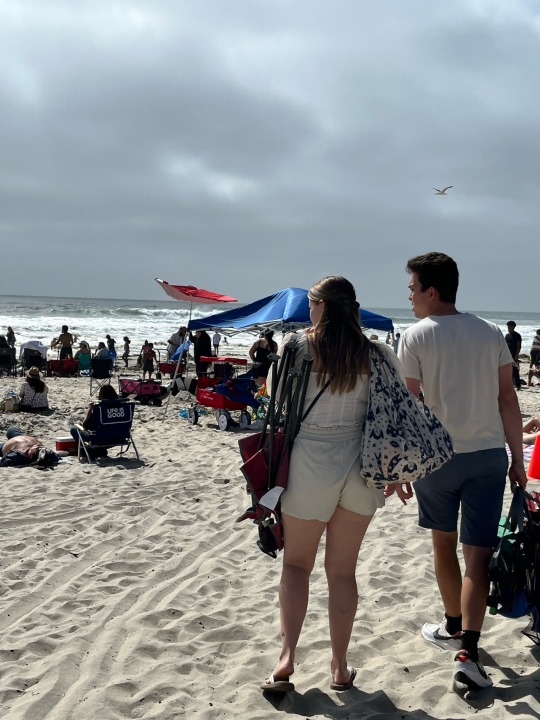



3 notes
·
View notes
Note
Visenya at 13, hearing Aurelian’s full title for the first time: Ugh that’s so obnoxious, why would anyone want to be called something so ostentatious? I would never punish my son or the pages by making him have some long puffed up mama
Visenya at age 20, returning to the Spring Court for the first time in three years: Please use my son’s full title; His Exalted Highness, Crown Prince Theomore, heir to the throne of the Autumn Court and son of the Noble and Ancient House de Lioncourt
Visenya’s own title as High Queen is Her Exalted Majesty Visenya Astraea Regina of the Noble and Ancient House de Lioncourt, High Queen of the Autumn Court; which is obviously a mouthful so she shouldn’t be complaining but girl does love to brag
And yes Aurelian’s title was the same as Theomore’s back when he was Crown Prince
And yes, her naming her son Theomore is a spoiler
Please Riley, as someone who actually lives in a kingdom with a whole-ass king, I can tell you that that isn't a mouthful of a full name.
*My* King's full name (titles included) is: His majesty Felipe Juan Pablo Alfonso de Todos los Santos de Borbon y Grecia (aka Felipe VI of Spain), King of Spain, Castilla, Leon, Aragon Navarra, Granada, Jerusalem, Toledo, the Two Sicilies, Valencia, Galicia, Mallorca, Menorca, Sevilla, Sardinia, Cordoba, Murcia, Jaen, the Algarves, Algeciras, Gibraltar, the Canary Islands, the East and West Indies, the 'Isles and Lands of the Oceanic Sea', Hungary, Dalmatia and Croatia; Archduke of Austria; Duke of Burgundy, Brabant, Milan, Athens, Neopatras, Limburg, Lotharingia, Luxembourg, Gelderland, Styria, Carniola, Carinthia and Württemberg; Count of Habsburg, Flanders, the Tyrol, the Rousillon, Barcelona, Artois, Hainaut, Namur, Gorizia, Ferrette, Kyburg and Goceano; Count Palatine of Borgoña; Lord of Vizcaya, Molina, Salins-les-Bains, Mechelen, Slovenia, Pordenone and Tripoli; Landgrave of Alsace; Prince of Swabia; Marquis of Oristano; Margrave of the Holy Roman Empire and Burgau; Captain General of the Armed Forces; and I'll stop now but there are MORE
Because we have a parliamentary monarchy many of those titles hold no power or are merely symbolic (literally like the king himself because he does no-thing) and are reminiscent of the time we were the Spanish empire and total pieces of shit, but I do urge you to add more titles to your ocs lol
2 notes
·
View notes
Photo
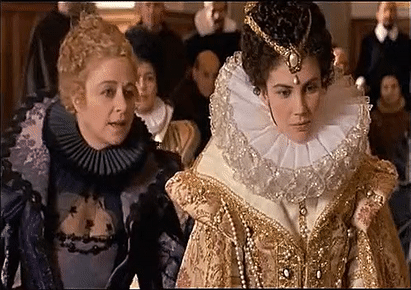



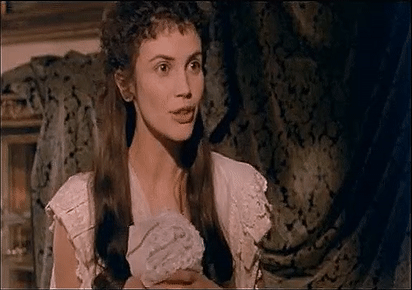



Philip IV of Spain and Elisabeth of France
When Elisabeth of France, the eldest daughter of King Henri IV and Marie de Medici, arrived at the Spanish court, Elisabeth under went significant change from a carefree young girl to a serious politician in her own right, acquiring political experience that would serve the crown well during the last years of her life. As the political situation grew more complicated, Elisabeth responded competently to the important matters that Philip IV gradually began to delegate to her. Elisabeth of France’s period of governance came at a crucial moment for the Spanish Monarchy, from 1642 to 1644, when it was undergoing an intense economic, military, and political crisis. At this same time, the king’s favourite and minister Count-Duke of Olivares fell from power,creating a vacuum that the queen hurried to fill, and her political influence notably increased after January 1643.
Even though the power she wielded was necessarily delegated by Philip IV, in times of political crisis, her role crucially influenced the Spanish government. While Olivares’s fall had facilitated her assuming this role, it was the queen’s extraordinary political skills and, in particular, her success in negotiating financial support and military maneuvers that proved she was equal to the task of governing in the king’s absence. The first time the queen had been given power were the years 1626 and 1632, when the king left Madrid to summon the Cortes or Parliaments of Aragon, Valencia, and Catalonia.
In August 1627, the queen’s role took on greater importance, as the king became seriously ill, precipitating one of the most critical moments of his reign. Given what seemed to be the likelihood of his death, Philip wrote a will and testament according to which Elisabeth, who was pregnant at the time, would become regent until the unborn child, if a son, would reach majority. If a daughter, she was to marry her paternal uncle, the infante Carlos, and the couple would inherit the crown. The king recovered the first week of September.
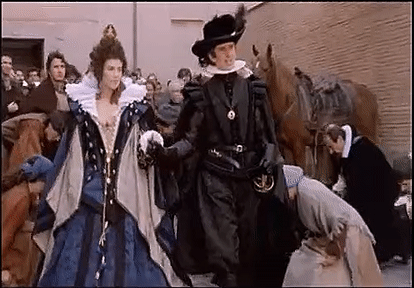
The revolt of Catalonia, which began on June 7, 1640, was followed by the revolt of Portugal in December that same year. These unprecedented rebellions within the Iberian peninsula coincided with other armed conflicts through out Europe in which Spain participated. France had declared war on Spain just five years earlier, and since then, Philip IV had mentioned several times that he wished to go to the battlefront. News that Louis XIII had visited the French troops in March 1642 caused Philip to visit his as well. He departed from Madrid in April 1642, leaving Elisabeth and her son, Baltasar Carlos, in tears. In addition to her activities with the Junta de Gobierno, the queen attended council meetings and royal ceremonies in the company of Baltasar Carlos, who had just turned thirteen. Her actions as head of government served as an example to the young prince. The queen took charge of the government for nearly eight months, until the king returned in early December.
Elisabeth had two main concerns during her final year as governor: first, she had to find the monies to supply the armies fighting both the Catalonian rebels and the French; and second, she had to secure funds for the defense of the Portuguese border. In both cases she was assisted by Chumacero, the Council president, with whom she consulted daily. Thanks in part to her efforts, the army at long last achieved several victories in 1644. Philip and Elisabeth wrote to each other regarding government affairs, just as Charles V and Empress Isabel had done a century earlier. Elisabeth of France retained an active role in governance until September 1644, when the first symptoms of erysipelas, the disease that would eventually lead to her death, first appeared. A few days after his wife’s death, in a letter to the queen’s close friend, the Countess of Paredes, the king wrote,
“Countess, you may judge how I have reached this point; in one day I have lost my wife, my friend, my helper and counselor in all my labors. Surely I must be made of bronze, for I have not lost my mind or my life.”
Source:
Alejandra Franganillo Álvarez, Isabel de Borbón and the Governance of the Spanish Monarchy
#Philip IV of Spain#Felipe IV de España#Isabel de Borbón#Elisabeth of France#couples in history#Spanish history
52 notes
·
View notes
Photo
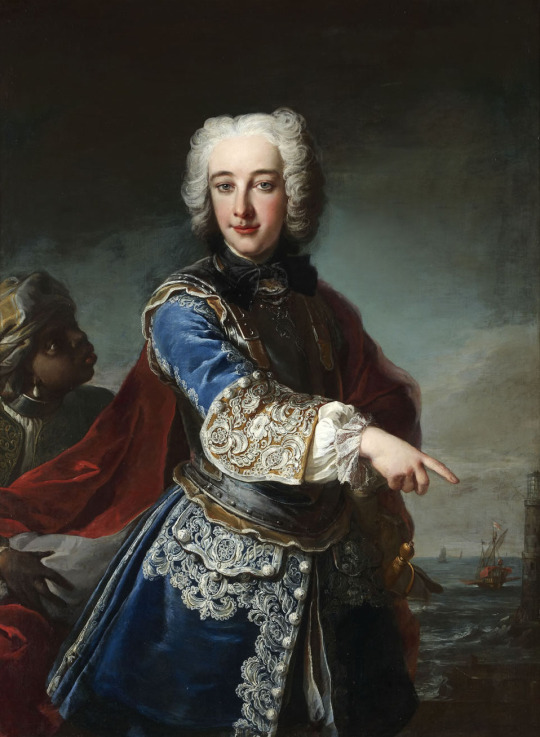
Louis-Michel van Loo (French, 1707 - 1771) Aparece este cuadro en el catálogo de 1830, que dice: “Retrato del 3er Duque de Liria, en más de medio cuerpo, vestido de azul, con un negro a su espalda y señalando el mar.” (This painting appears in the 1830 catalogue, which says: "Portrait of the 3rd Duke of Liria, in more than half length, dressed in blue, with a black man behind him and pointing to the sea), ca. 1725 - 50 Colección de la Fundación Casa de Alba
Jacobo Francisco Eduardo Fitz-James Stuart y Colón de Portugal, 3rd Duke of Berwick, 3rd Duke of Liria and Jérica, 9th Duke of Veragua, 9th Duke of la Vega (28 December 1718 – Valencia, 30 September 1785) was a Spanish Jacobite. On the death of his father, James Fitz-James Stuart, in 1738, he inherited his titles of Duke of Berwick and Duke of Liria and Xerica. (He also possessed many other titles in both Spain and England.) His mother was Spanish, and on her side he was a direct descendant of explorer Christopher Columbus. On 26 July 1738, in Alba de Tormes, he married Maria Teresa de Silva y Alvarez de Toledo (6 May 1716 – 5 May 1790), daughter of Manuel Maria de Silva y Mendoza, (born 18 October 1677), 9th Conde de Galve, 7th son of the 5th Duke of Pastrana and Estremera and of the outstandingly wealthy Maria Teresa Alvarez de Toledo, (18 September 1691 – 1755), 11th Duquesa de Alba de Tormes, 8th duquesa de Huéscar, 4th Duquesa de Montoro, 6th Duquesa de Olivares, 7th Duquesa de Galisteo, Grandee of Spain, and a number of lesser Spanish noble titles (such as Marquessats, Earldoms, Baronetages, Viscountships and Lordships). Their only son to survive to adulthood was Carlos Bernardo Fitz-James Stuart y de Silva, (Liria, Valencia, 25 March 1752 – Madrid, 7 September 1787). Titles: 3rd Duke of Berwick, 3rd Duke of Liria and Xérica, Grandee of Spain 1st Class, 10th Duke of Veragua, 10th Duke of la Vega, 3rd Earl of Tinmouth, 9th Count of Gelves, 3rd Baron Bosworth.
#wish i had that many titles#art#classical art#louis michel van loo#french#france#french art#french man#male#portrait#man#powdered wig#europe#european#european art#english#spanish#spain#classical#portugal#western europe#18th century#1700s#fine art#fine arts#traditional art#western civilization#western culture
20 notes
·
View notes
Text
ARC Review of The Duchess by Sophie Jordan

Rating: 3.5/5 Heat Level: 3/5 Publication Date: March 26th
Premise:
Valencia is a widowed duchess who is finally free to do as she pleases. The new heir to the dukedom is finally found and it turns out to be Rhian, a Welsh businessman Valencia finds herself inconveniently attracted to. In exchange for helping Rhian's sisters navigate the ton, Rhian agrees to give Valencia financial security and the freedom to leave.
My review:
This was low-heat and relatively short (218 pages) as far as historical romances go. Valencia is in her early thirties, a popular matron of the ton, and finally free to be as merry a widow as she pleases now that her husband is dead. Sophie Jordan has not shied away from writing HORRIFICALLY shitty husbands in her Scandalous Ladies of London series, and the late Dedham haunts Valencia for much of the book. What I found particularly poignant was the rightful blame Valencia placed on not only her husband for his various abuses, but also her father for not protected her when he held all the power to decide her future and her marriage. It feels very real for the time period and drives home the point just how much power men held back in the day.
And Valencia isn't perfect; she's a bit of a snob when it come's to Rhian's countrified sisters initially, and she spends most of the book antagonizing her stepmother Hazel, who is actually younger than Valencia, and was a sex worker before she married Valencia's father. There are a few chapter's in Hazel's POV, and by the end of The Duchess, her romance is set up and Valencia finally begins to realize her hatred is unfounded.
I think where the book fell short of my expectations was with the hero Rhian, and his chemistry with Valencia. Rhian is big, Welsh, a competent businessman (a Rhys Winterborne type superficially, but he doesn't go as hard as Rhys lol), and initially hates that he's attracted to Valencia. But that hatred feels pretty tepid all things considered, and while I could see where that "hatred" morphed into grudging respect, I really could not make out where their attraction, and even their love began. It felt like there was no good reason, apart from base attraction and the low bar of Rhian willing to listen to and support Valencia while her late husband and the men around her never did.
Here's my thing: like I said in my review of the first book in this series, The Countess (see here), a friendship between a bunch of popular, disenchanted older women as a concept is fun, but so far both heroines have spent most of their books quite miserable, and the romantic and sexual payoff with their heroes has been middling at best.
The sex:
There were 1.5 sex scenes in this book. I say .5 because one was vaguely described in a paragraph and mostly glossed over. There is a *mounting* moment in this book, which I did appreciate, but otherwise the sex scenes were... underwhelming. I'm starting to feel like this is a pattern for this series.
Overall:
Like I said earlier, if low-heat, short historical romances with family and marital drama are your jam, you'll enjoy this book. I for one am quite curious about the next book in this series, which features Valencia's stepmom Hazel, who is put in a predicament very similar to Jayne in Lorraine Heath's Waking Up With the Duke...
Thank you to Avon and Harper Voyager and NetGalley for an advanced copy of this book in exchange for my review.
#arc#arc review#netgalley#sophie jordan#historical romance#avon books#avon#Harper Voyager#romance novel#romance novels
2 notes
·
View notes
Text

Miracle Choice (미라클 초이스) - Korean interactive romance Game (Choice Stories)

Become the protagonist of captivating stories and change the ending.
........................................
Game: Sugar Wonderland (슈가 원더랜드)
By: Sogon Labs
Platform: Android
Language: Korean
Twitter: https://twitter.com/LabsSogon
........................................
Multi-ending dating simulation story game.
3 Games in 1 app แอปรวมเกมจำลองความรักจีบหนุ่มจีบสาว

✦ Sugar Wonderland (슈가 원더랜드)
Isabell Rose (MC), you who possessed into the romance.
But, something... Aren't the settings weird?
My fiance is the Grand Duke of the North?!
คุณที่หลงเข้าไปในเรื่องราวโรแมนซ์
แต่บางอย่าง... ไม่แปลกไปเหรอ?
คู่หมั้นของฉันคือแกรนด์ดยุก?!
✦ CHARACTERS

Michael Valencia - Duke of North
“Look. Who's the man holding you right now?”
There seemed to be a warm heart behind a cold face.

Lucian Calix - The charmer
“I'm that Calix, lady. What's the matter?”
The charmer is insidious enough to seduce you married.

Ian Calix - wait for update
“Stop acting up. Try to be a good girl”
ไมเคิล วาเลนเซีย - ดูเหมือนจะมีหัวใจอบอุ่นอยู่เบื้องหลังใบหน้าเย็นชานั้น
"ลืมตาดูก่อนสิ ว่าคนที่อุ้มเธออยู่ตอนนี้คือใคร”
ลูเซียน คาลิกซ์ - ผู้มีเสน่ห์ร้ายกาจพอที่จะหลอกล่อคุณที่แต่งงานแล้ว
“ผมคือคาลิกซ์ มีอะไรเหรอครับ เลดี้?”
เอียน คาลิกซ์ - ยังไม่มีข้อมูล
"หยุดแสดง แล้วทำตัวเป็นเด็กดีซะ”
✦ DOWNLOAD
Android: https://play.google.com/store/apps/details?id=com.sogon.miracle
ANOTHER GAMES

◆ The Great Gatsby (위대한 개츠비)
“How fares, my lady? I've been waiting for you.”
Caroline Smith (MC), After a long time, you met your first love.
But, that wasn't the only thing waiting for you...

◆ Crow Connect (크로우 커넥트)
“Welcome!”
Han Iseol (MC), You are a person with unique abilities.
A certain beauty makes a proposal to you who are having trouble going to school or getting a job...
Yeah? You want me to help people date?!
17 notes
·
View notes
Text
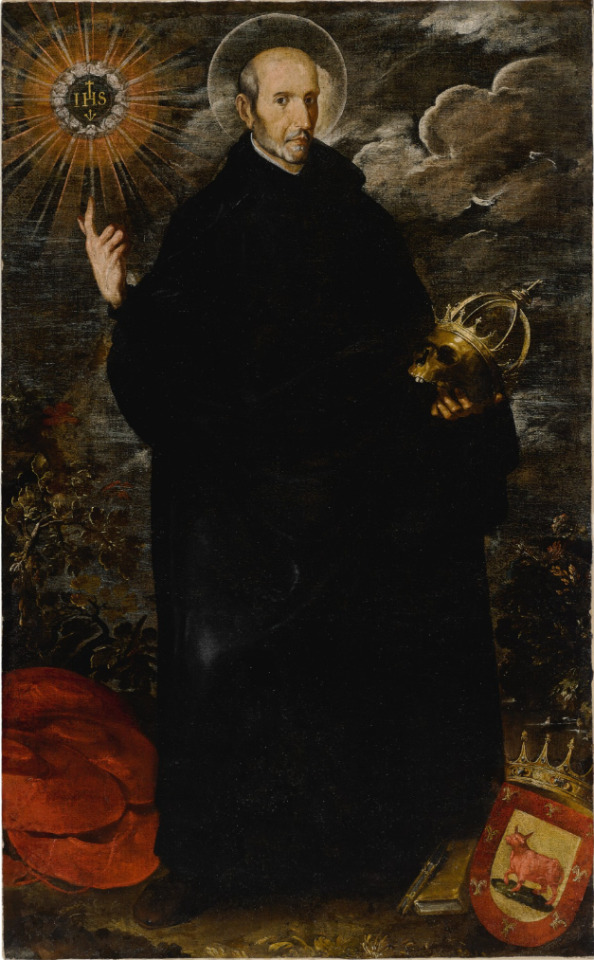
THE DESCRIPTION OF SAINT FRANCIS BORGIA The Patron Against Earthquakes Feast Day: September 30, October 3 (Jesuit calendar)
Francis Borgia (Francisco de Borja y Aragón) gave up incredible wealth, power and privilege as a Spanish nobleman to enter the Society of Jesus where his experience brought him to leadership as the third superior general of the young Society of Jesus. The oldest son of the third duke of Gandía, Borgia was born in the family palace in Valencia. His great grandfather on his father's side was Pope Alexander VI, and his mother's grandfather was King Ferdinand the Catholic.
Like other young nobles he was trained for life at court, and in 1522 was appointed page to his cousin Catherine, the sister of Emperor Charles V who invited him back to court after he studied philosophy for three years. In 1529, he married Leonor de Castro of Portugal, Empress Isabella's first lady-in-waiting. The 20 year-old Borgia was honored by the Emperor who named him Marquis of Llombai, and placed him in charge of the imperial household. During the next 10 years, Francis and Eleanor had eight children and lived in great familiarity with Charles and Isabella, until the Empress unexpectedly died on May 1, 1539.
Her death led directly to Borgia's conversion when Francis accompanied the funeral cortege to the burial place in the royal chapel in Granada. When the coffin was opened, he saw not the beautiful face of the 36-year-old queen, but a face beyond recognition. Not wanting to serve another master who would die, he began to devote himself to prayer and penance.
After he returned from Granada, he was appointed Viceroy of Catalonia in June 1539, and then became the fourth duke of Gandía after his father died four years later. He returned to the family palace to manage his estates, but when his wife Leonor died March 27, 1546, he resolved to dedicate the rest of his life to God's service. He was familiar with the Jesuits, having founded a Jesuit college in Gandía and being a personal friend of Father Peter Favre whom he asked to inform Ignatius of his decision. Ignatius welcomed him into the Society but recommended that he tell no one until he arranged affairs for his children and finished studying theology. Meanwhile, the founder of the Jesuits encouraged the duke to continue living as a nobleman. Francis pronounced his vows as a Jesuit on Feb. 1, 1548 and on Aug. 20, 1550 earned a doctorate in theology from the university which he himself had founded.
Since 1550 was a Holy Year, Francis took the opportunity to make a pilgrimage to Rome so he could visit Ignatius and arrange his public entrance into the Society of Jesus. He left his home in Gandía, never to see it again, and lodged in the Jesuit residence in Rome with Ignatius rather than taking Pope Julius III's offer to stay in the Borgia apartments in the Vatican. After living as a Jesuit from the end of October until early February 1551, he returned to Spain where he resigned his title in favor of his son, Carlos. As soon as he received the Emperor's letter accepting his resignation, Francis donned the Jesuit cassock. He was ordained a priest on May 23 and celebrated his first Mass in the chapel in the Loyola family home.
For a few years Borgia worked as an ordinary parish priest. In 1554 he was named Commissary General in Spain, with power over provincials in Spain and Portugal. He founded Spain's first novitiate, at Simancas, and set up over 20 schools. He did not attend the first general congregation, convened almost two years after Ignatius died, but did return to Rome in 1561 at Pope Pius IV's request. He was chosen to be vicar general when Father James Laínez, who succeeded Ignatius as superior general, attended the last session of the Council of Trent. Upon Laínez's return, Borgia became assistant for Spain and Portugal, and then was elected to succeed Laínez after his death in 1565.
Borgia served as the third superior general of the Jesuits for seven years and devoted himself to revising the Society's rules, expanding its missions in India and the Americas, and shepherding the growth of the young Society.
His final project was a mission to Spain accompanying Cardinal Michele Bonelli in an effort to secure Spain's help against the Turks. The two churchmen left Rome in June 1571, and arrived in Barcelona by the end of August. Borgia was overwhelmed by the reception he received from people who had known him as a nobleman and honored his choice of religious life. In December, Borgia left Spain for France to continue the diplomatic mission, but he fell ill from fever and pleurisy because of the unusually cold. He had to spend weeks resting in Turin on the return trip to Rome and then stayed with relatives in Ferrara during the summer.
Finally, he set out for Rome on Sept. 3, 1572, going to bed immediately upon his arrival. His final illness lasted three days before the 61-year-old general died during the night of September 30.
Source: jesuits.global
#random stuff#catholic#catholic saints#francis borgia#francisco de borja y aragó#francisco borja#jesuits#society of jesus
4 notes
·
View notes